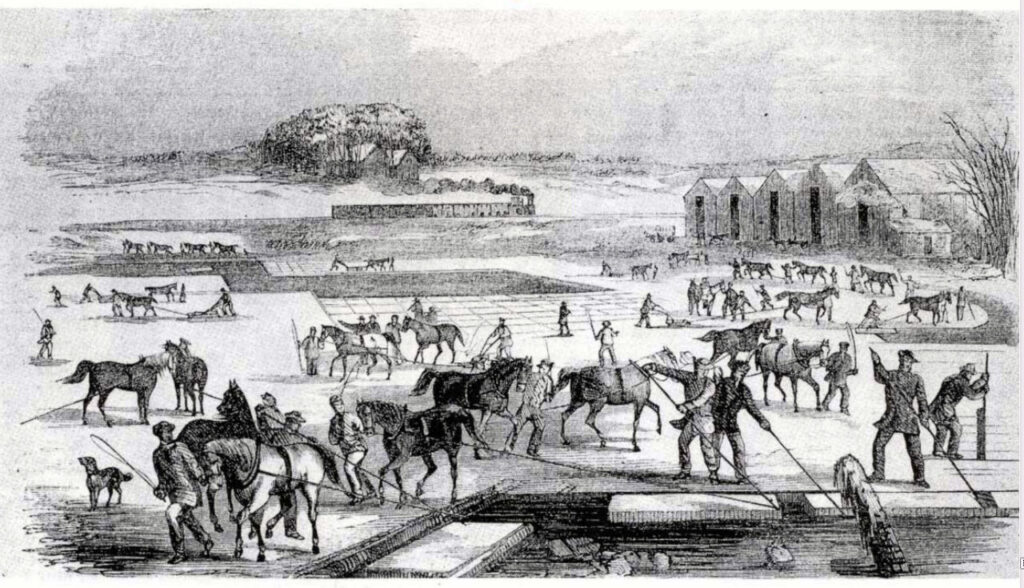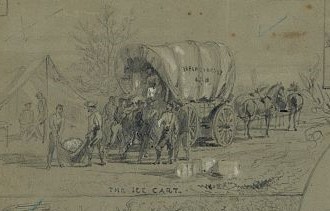Table of Contents
Ice was considered a standard medical necessity and was supplied to Civil War hospitals in mass quantity by the Medical Purveyors. The per diem allowance for each patient in hospitals south of Washington, DC, was one pound; the allotment north of Washington was one-half pound. The ice was either procured from local dealers or shipped to the hospitals by the Medical Department, usually by rail. There is evidence that “large quantities of ice were also forwarded for the use of armies engaged in active hostilities,” but the exact methods of shipment and storage are unknown.

In the winter, ice was harvested in large blocks from ponds, lakes, and rivers and stored in ice houses for use throughout the year. Straw was usually used as insulation. One extreme example is from Little Rock, Arkansas, in January 1864. The temperature dropped to 12 degrees below zero, cold enough to freeze the Arkansas River. A large icehouse was commandeered, and wagons and a detail of men were supplied for the task of harvesting the ice. More than two hundred tons of ice were procured and became the main supply for the hospitals in Little Rock for nearly all of 1864. Most of the hospital complexes had their own icehouses on site.
Many hospital steamers also had provisions for ice and cold water. The D. A. January had an elaborate system for cooling drinking water, where water from holding tanks passed through two large ice-chests in the hold of the boat. In the chests were large “worms” which carried the water, cooling it as it flowed past the ice. The water was then piped around the ship. This system saved a large amount of ice since the ice-chests were rarely opened.

Ice was used for many hospital purposes in addition to the obvious ones of chilling water and making ice cream, a holiday treat. Some uses were: as an anti-inflammatory to reduce the swelling of various diseases and wounds, including broken bones; to help in healing surgical scars; to stop hemorrhage; to treat bedsores; to reduce fevers; as cold-water dressings; as an external application in tetanus cases; and in at least one instance to successfully treat diphtheria. The following is the diphtheria case study from The Medical and Surgical History of the Civil War:
Surgeon A. Hammer, U. S. Vols., St. Louis, Mo., Sept 11, 1863.– I take the liberty of bringing to notice a case of considerable importance that occurred in my hospital, in which there was used a new remedy. On September 1 I was called by Dr. Leffingwell to see a patient suffering from diphtheria. The patient had complained the evening before of great dyspnea and painful sensations about the throat which had been relieved by the application of a solution of nitrate of silver. I found the case one of well-marked and extensive diphtheria; the tonsils, soft palate and uvula on both surfaces being covered with thick grayish-white, continuous, croupous exudations. Knowing the uncertainty of our present treatment of this insidious disease, I concluded to prescribe the swallowing of small bits of ice continuously, as I had seen recommended in a journal article by a French surgeon. Next day the diphtheritic exudations were more marked and the case aggravated; but to give the treatment a fair trial I ordered its continuance, and in addition ice compresses around the neck. On the 3rd the progress of the disease had been arrested and parts of the membranes thrown off by coughing. The ice was continued for two days more, during which time the exudations became steadily thinner, and on the 8th recovery was perfect. Should the ice prove as beneficial in other cases as in this it would be a great blessing for mankind. I have no reason to doubt that the exudative processes are checked by the action of cold upon the capillaries.
About the Author
Terry Reimer is the Director of Research the National Museum of Civil War Medicine in Frederick, MD. Her prior work includes experience in historical archaeology and research, specializing in 17th, 18th, and 19th century American sites. Reimer is the author of three books on Civil War medical history, co-author of two more, and the editor of Clara Barton: Civil War Humanitarian.


